2008 MERCEDES-BENZ SL ROADSTER child seat
[x] Cancel search: child seatPage 8 of 317
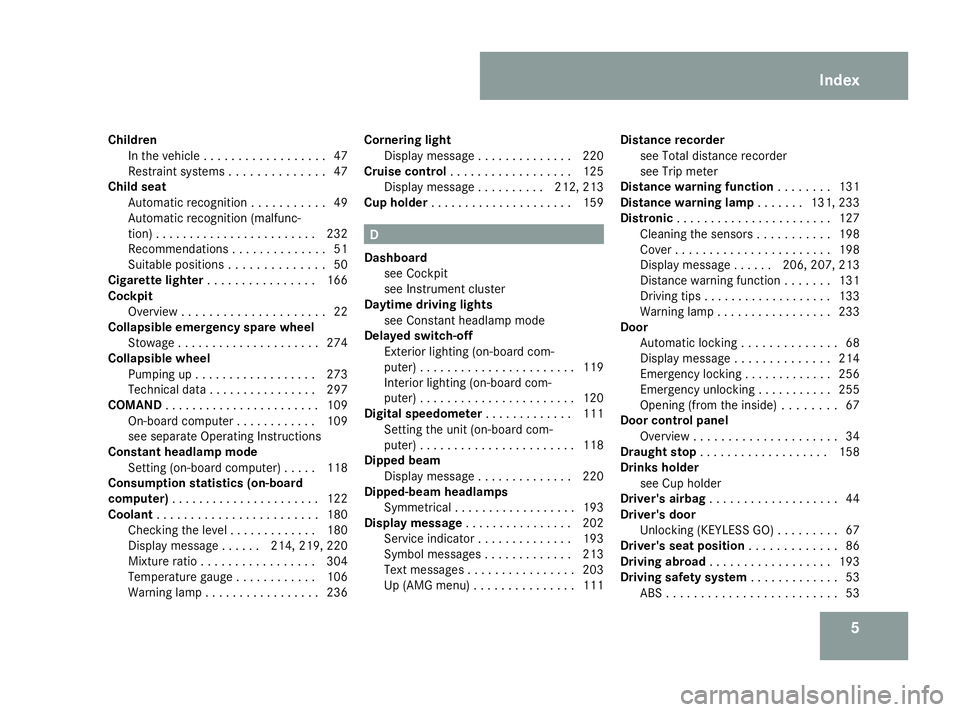
5
Children
In th evehicle .................. 47
Restrai ntsystems .............. 47
Chil dseat
Automatic recognition ...........49
Automatic recognition (malfunc-
tion) ........................ 232
Recommendations ..............51
Suitable positions .............. 50
Ciga rettel ighter ................ 166
Cockpit Overview ..................... 22
Collapsible emergency spare wheel
Stowage ..................... 274
Collapsibl ewheel
Pumping up .................. 273
Technical data ................ 297
COMAND ....................... 109
On-board computer ............109
see separate Operating Instructions
Constant headlamp mode
Setting (on-board computer) .....118
Consumptio nstatistic s(on -board
computer) ...................... 122
Coolant ........................ 180
Checking the leve l.............180
Display message ......214, 219, 220
Mixture ratio ................. 304
Temperature gauge ............106
Warning lamp ................. 236Cornerin
glight
Display message .............. 220
Cruis econtrol .................. 125
Display message ..........212, 213
Cup holder ..................... 159 D
Dashboard see Cockpit
see Instrument cluster
Daytime drivin glights
see Constant headlamp mode
Delaye dswitch-off
Exterior lighting (on-board com-
puter) ....................... 119
Interior lighting (on-board com-
puter) ....................... 120
Digital speedometer .............111
Setting the unit (on-board com-
puter) ....................... 118
Dipped beam
Display message .............. 220
Dipped-beam headlamps
Symmetrical .................. 193
Display message ................ 202
Service indicator .............. 193
Symbo lmessages ............. 213
Text messages ................ 203
Up (AMG menu) ............... 111Distanc
erecorder
see Total distance recorder
see Trip meter
Distanc ewarning function ........131
Distanc ewarning lamp .......131, 233
Distronic ....................... 127
Cleaning the sensors ...........198
Cove r....................... 198
Display message ......206, 207, 213
Distance warning function .......131
Driving tips ................... 133
Warning lamp ................. 233
Door
Automatic locking .............. 68
Display message .............. 214
Emergency locking .............256
Emergency unlocking ...........255
Opening (from the inside) ........67
Door control panel
Overview ..................... 34
Draught stop ................... 158
Drinks holder see Cuph older
Driver's airbag ................... 44
Driver's door Unlocking (K EYLESS GO) ......... 67
Driver's seat position .............86
Drivin gabroad .................. 193
Driving safety system .............53
ABS ......................... 53 Index
230_AKB; 5; 4, en-GB
bjanott,
Version: 2.9.6 2008-04-08T15:09:54+02:00-Seite 5 Dateiname: 6515_3089_02_buchblock.pdf; preflight
Page 14 of 317
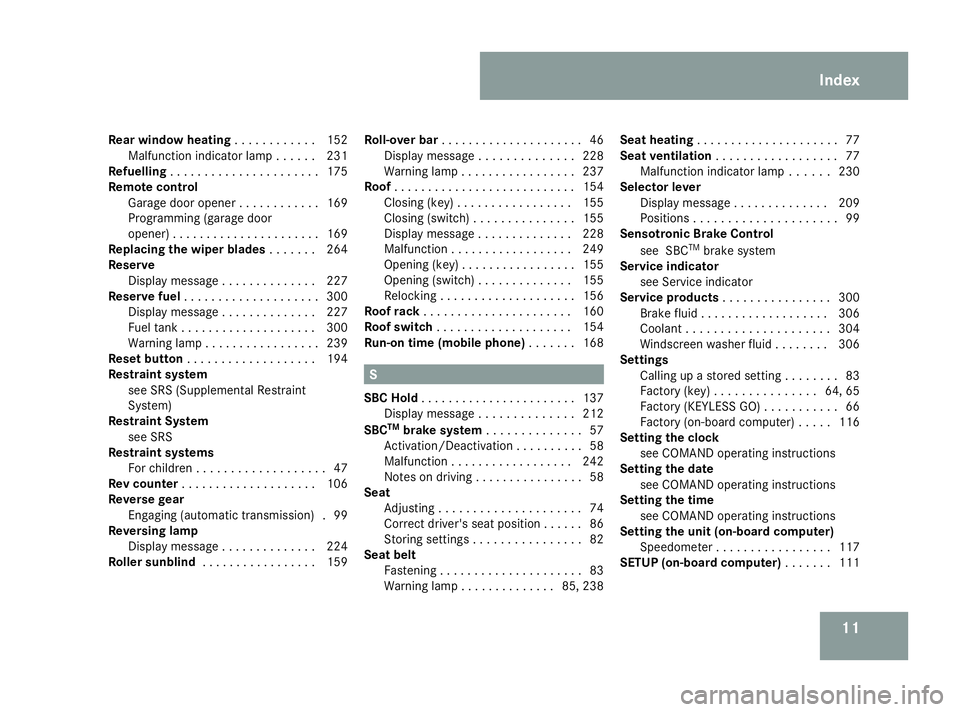
11
Rear window heating
............152
Malfunction indicator lamp ......231
Refuelling ...................... 175
Remote control Garage door opene r............ 169
Programming (garage door
opener) ...................... 169
Replacing the wiper blades .......264
Reserve Display message .............. 227
Reserve fuel .................... 300
Display message .............. 227
Fuel tank .................... 300
Warning lamp ................. 239
Rese tbutton ................... 194
Restrain tsystem
see SRS (Supplemental Restraint
System)
Restrain tSystem
see SRS
Restrain tsystems
For children ................... 47
Rev counter .................... 106
Reverse gear Engaging (automatic transmission) .99
Reversin glamp
Displa ymessag e.............. 224
Roller sunblind ................. 159Roll-ove
rbar..................... 46
Display message .............. 228
Warning lamp ................. 237
Roof ........................... 154
Closing (key )................ .155
Closing (switch) ............... 155
Display message .............. 228
Malfunction .................. 249
Opening (key )................. 155
Opening (switch) .............. 155
Relocking .................... 156
Roof rack ...................... 160
Roof switch .................... 154
Run-on time (mobile phone) .......168 S
SBC Hold ....................... 137
Display message .............. 212
SBC TM
brake system .............. 57
Activation/Deactivatio n.......... 58
Malfunctio n.................. 242
Notes on driving ................ 58
Seat
Adjusting ..................... 74
Correct driver's seat position ......86
Storing settings ................ 82
Seat belt
Fastening ..................... 83
Warning lamp .............. 85, 238Seat heating
..................... 77
Seat ventilation .................. 77
Malfunctio nindicator lamp ......230
Selector lever
Display message .............. 209
Positions ..................... 99
Sensotronic Brake Control
see SBC TM
brak esystem
Service indicator
see Service indicator
Service products ................ 300
Brake fluid ................... 306
Coolant ..................... 304
Windscreen washer fluid ........306
Settings
Calling up astored setting ........83
Factory (key ).............. .64, 65
Factory (KEYLESS GO) ...........66
Factory (on-board computer) .....116
Settin gthe clock
see COMAND operating instructions
Settin gthe date
see COMAND operating instructions
Settin gthe time
see COMAND operating instructions
Settin gthe unit (on-board computer)
Speedometer ................. 117
SETUP (on-board computer) .......111 Index
230_AKB; 5; 4, en-GB
bjanott,
Version: 2.9.6
2008-04-08T15:09:54+02:00
-Seite 11 Dateiname: 6515_3089_02_buchblock.pdf; preflight
Page 46 of 317
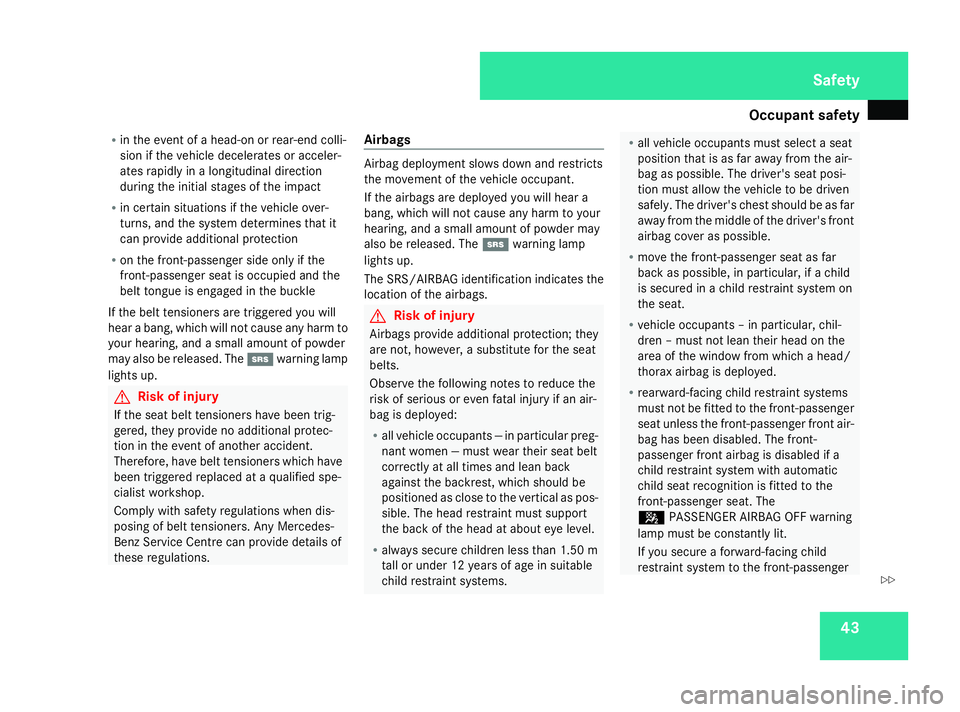
Occupant safety
43
R
in the event of ahead-on or rear-en dcolli-
sion if the vehicle decelerates or acceler-
ates rapidly in alongitudinal direction
during the initial stages of the impact
R in certain situation sifthe vehicle over-
turns, and the system determines that it
can provide additional protection
R on the front-passenger side only if the
front-passenger seat is occupied and the
belt tongue is engaged in the buckle
If the belt tensioners are triggered you will
hear abang, which will not cause any harm to
your hearing, and asmall amount of powder
may also be released. The 1warning lamp
lights up. G
Risk of injury
If the seat belt tensioners have been trig-
gered, they provide no additional protec-
tion in the event of another accident.
Therefore, have belt tensioners which have
been triggered replaced at aqualified spe-
cialist workshop.
Comply with safety regulations when dis-
posing of belt tensioners .Any Mercedes-
Ben zService Centr ecan provide details of
these regulations. Airbags Airbag deployment slows down and restricts
the movement of the vehicle occupant.
If the airbags are deployed you will hear a
bang, which will not cause any harm to your
hearing, and
asmall amount of powder may
also be released. The 1warning lamp
lights up.
The SRS/AIRBAG identification indicates the
location of the airbags. G
Risk of injury
Airbags provide additional protection ;they
are not ,however, asubstitute for the seat
belts.
Observe the following notes to reduce the
risk of serious or even fatal injury if an air-
bag is deployed:
R all vehicle occupants —inparticular preg-
nant women —must wear their seat belt
correctly at all times and lean back
against the backrest, which should be
positioned as close to the vertical as pos-
sible. The head restraint must support
the back of the head at about eye level.
R alway ssecure children less than 1.5 0m
tall or under 12 years of age in suitable
child restraint systems. R
all vehicle occupants must select aseat
position that is as far away from the air-
bag as possible. The driver's seat posi-
tion must allow the vehicle to be driven
safely. The driver's chest should be as far
away from the middle of the driver's front
airbag cover as possible.
R move the front-passenger seat as far
back as possible, in particular, if achild
is secured in achild restraint system on
the seat.
R vehicle occupants –inparticular, chil-
dren –must not lean their head on the
area of the window from which ahead/
thorax airbag is deployed.
R rearward-facing child restraint systems
must not be fitted to the front-passenger
seat unless the front-passenger fron tair-
bag has been disabled. The front-
passenger fron tairbag is disabled if a
child restraint system with automatic
child seat recognition is fitted to the
front-passenger seat. The
5 PASSENGER AIRBAG OFF warning
lamp must be constantly lit.
If you secure aforward-facin gchild
restraint system to the front-passenger Safety
230_AKB
;5;4,en-GB
bjanott, Version:2.9.6
2008-04-08T15:09:54+02:0
0-Seite 43 ZDateiname: 6515_3089_02_buchblock.pdf; preflight
Page 48 of 317
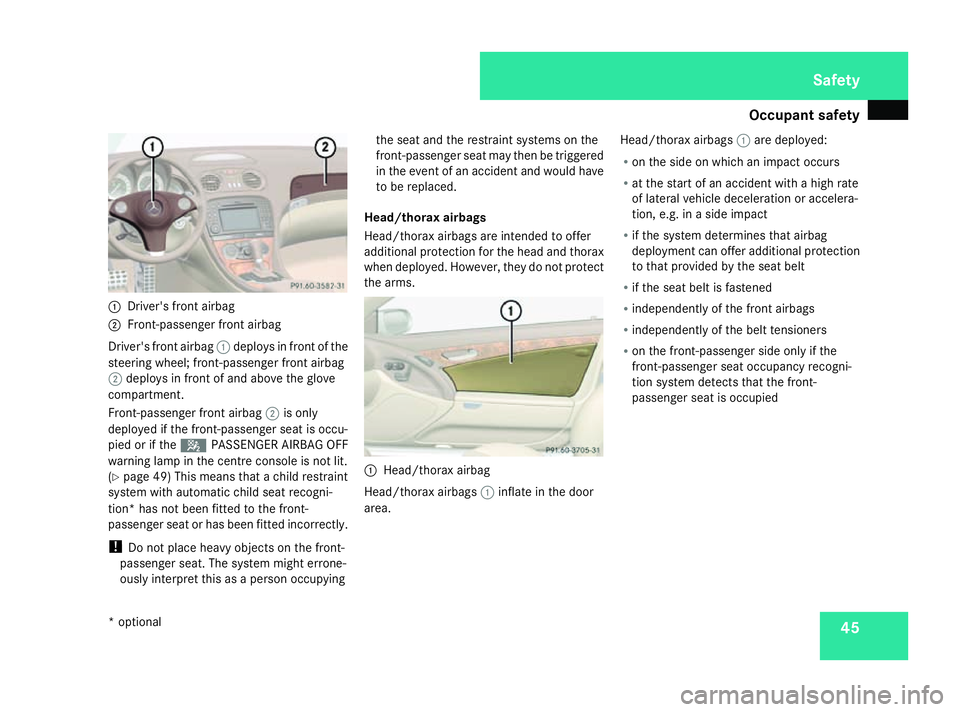
Occupant safety
451
Driver's front airbag
2 Front-passenger front airbag
Driver's front airbag 1deploysinf ront of the
steering wheel; front-passenger front airbag
2 deploysinf ront of and above the glove
compartment.
Front-passenger front airbag 2is only
deployed if the front-passenger seat is occu-
pied or if the 5PASSENGER AIRBAG OFF
warning lamp in the centre console is not lit.
(Y page 49) This means that achild restraint
system with automatic child seat recogni-
tion* has not been fitted to the front-
passenger seat or has been fitted incorrectly.
! Do not place heavy objectsont he front-
passenger seat. The system might errone-
ously interpret this as aperson occupying the seat and the restraint systems on the
front-passenger seat may then be triggered
in the event of an accident and would have
to be replaced.
Head/thoraxa irbags
Head/thorax airbags are intended to offer
additional protection for the head and thorax
when deployed. However, they do not protect
the arms. 1
Head/thorax airbag
Head/thorax airbags 1inflate in the door
area. Head/thorax airbags
1are deployed:
R on the side on which an impact occurs
R at the start of an accident with ahigh rate
of lateral vehicle deceleration or accelera-
tion, e.g. in aside impact
R if the system determines that airbag
deployment can offer additional protection
to that provided by the seat belt
R if the seat belt is fastened
R independently of the front airbags
R independently of the belt tensioners
R on the front-passenger side only if the
front-passenger seat occupancy recogni-
tion system detectst hat the front-
passenger seat is occupied Safety
*o ptional
230_AKB; 5; 4, en-GB
bjanott
,V ersion: 2.9.6
2008-04-08T15:09:54+02:00
-Seite 45 ZDateiname: 6515_3089_02_buchblock.pdf; preflight
Page 50 of 317
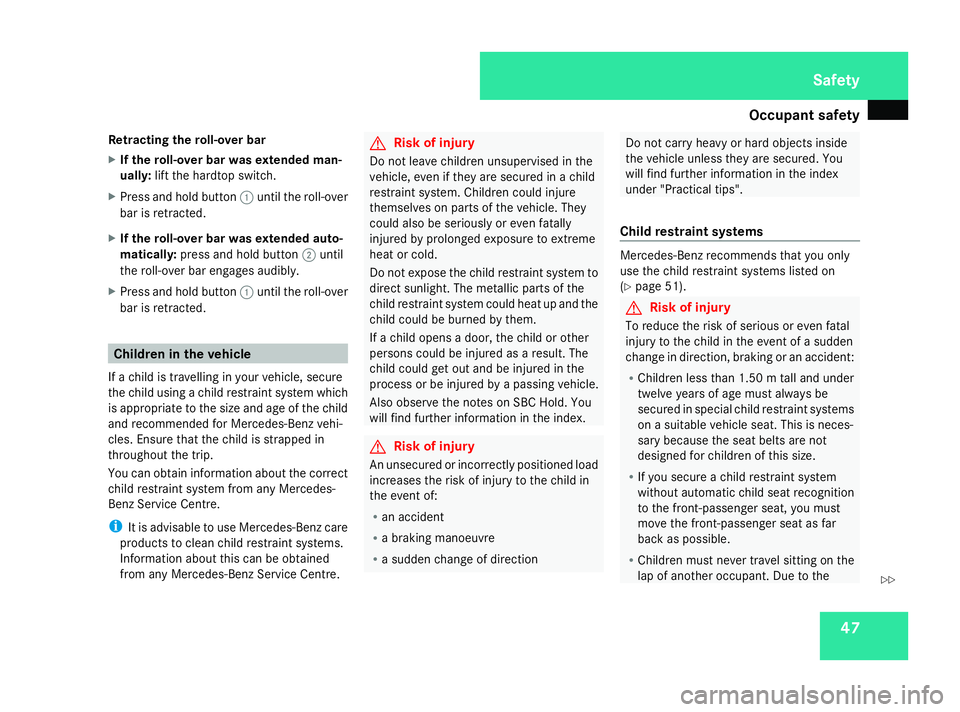
Occupant safety
47
Retracting the roll-over bar
X
If the roll-over bar was extended man-
ually: lift the hardtop switch.
X Press and hold button 1until the roll-over
bar is retracted.
X If the roll-over bar was extended auto-
matically: press and hold button 2until
the roll-over bar engages audibly.
X Press and hold button 1until the roll-over
bar is retracted. Children in the vehicle
If ac hild is travelling in your vehicle, secure
the child using achild restraint system which
is appropriate to the size and age of the child
and recommended for Mercedes-Benz vehi-
cles. Ensure that the child is strapped in
throughout the trip.
You can obtain information about the correct
child restraint system from any Mercedes-
Ben zService Centre.
i It is advisable to use Mercedes-Benz care
product stoclean child restraint systems.
Information about this can be obtained
from any Mercedes-Benz Service Centre. G
Risk of injury
Do not leave children unsupervised in the
vehicle, even if they are secured in achild
restraint system. Children could injure
themselves on parts of the vehicle. They
could also be seriously or even fatally
injured by prolonged exposure to extreme
heat or cold.
Do not expose the child restraint system to
direct sunlight .The metallic parts of the
child restraint system could heat up and the
child could be burned by them.
If ac hild opens adoor, the child or other
person scould be injured as aresult. The
child could get out and be injured in the
proces sorbei njured by apassing vehicle.
Also observe the notes on SBC Hold. You
will find further information in the index. G
Risk of injury
An unsecured or incorrectly positioned load
increases the risk of injury to the child in
the event of:
R an accident
R ab rakin gmanoeuvre
R as udden chang eofdirection Do not carry heavy or hard objects inside
the vehicle unless they are secured. You
will find further information in the index
under "Practical tips".
Child restraint systems Mercedes-Benz recommends that you only
use the child restraint systems listed on
(Y
page 51). G
Risk of injury
To reduce the risk of serious or even fatal
injury to the child in the event of asudden
chang eindirection, brakin goranaccident:
R Children less than 1.5 0mtall and under
twelve years of age must alway sbe
secured in special child restraint systems
on asuitable vehicle seat. This is neces-
sary because the seat belts are not
designed for children of this size.
R If you secure achild restraint system
without automatic child seat recognition
to the front-passenger seat, you must
move the front-passenger seat as far
back as possible.
R Children must never travel sitting on the
lap of another occupant. Due to the Safety
230_AKB
;5;4,en-GB
bjanott, Version:2.9.6
2008-04-08T15:09:54+02:0
0-Seite 47 ZDateiname: 6515_3089_02_buchblock.pdf; preflight
Page 51 of 317
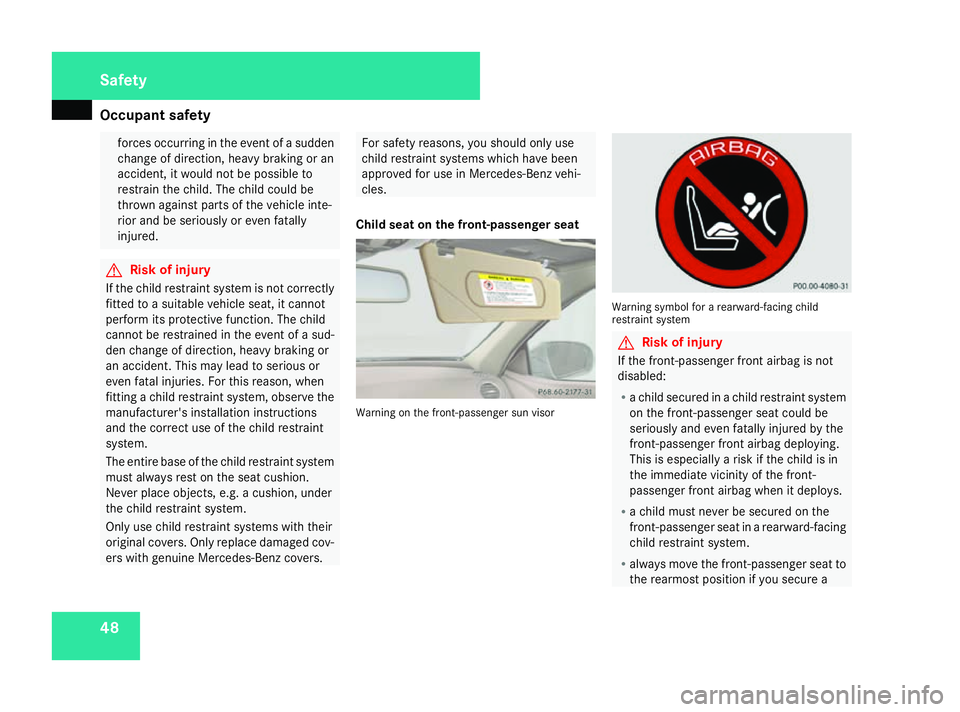
Occupant safety
48 forces occurring in the event of
asudden
chang eofdirection, heavy brakin goran
accident, it would not be possible to
restrain the child. The child could be
thrown against parts of the vehicle inte-
rior and be seriously or even fatally
injured. G
Risk of injury
If the child restraint system is not correctly
fitted to asuitable vehicle seat, it cannot
perfor mits protective function .The child
cannot be restrained in the event of asud-
den chang eofdirection, heavy brakin gor
an accident. This may lead to serious or
even fatal injuries. For this reason, when
fitting achild restraint system, observe the
manufacturer's installation instructions
and the correct use of the child restraint
system.
The entire base of the child restraint system
must alway srest on the seat cushion.
Never place objects, e.g. acushion ,under
the child restraint system.
Only use child restraint systems with their
original covers. Only replace damaged cov-
ers with genuine Mercedes-Benz covers. For safety reasons
,you should only use
child restraint systems which have been
approved for use in Mercedes-Benz vehi-
cles.
Child seat on the front-passenger seat Warning on the front-passenger sun visor Warning symbol for
arearward-facing child
restraint system G
Risk of injury
If the front-passenger front airbag is not
disabled:
R ac hild secured in achild restraint system
on the front-passenger seat could be
seriously and even fatally injured by the
front-passenger front airbag deploying.
This is especially arisk if the child is in
the immediate vicinity of the front-
passenger front airbag when it deploys.
R ac hild must never be secured on the
front-passenger seat in arearward-facing
child restraint system.
R always move the front-passenger seat to
the rearmost position if you secure a Safety
230_AKB; 5; 4, en-GB
bjanott
,V ersion: 2.9.6
2008-04-08T15:09:54+02:00
-Seite 48 Dateiname: 6515_3089_02_buchblock.pdf; preflight
Page 52 of 317
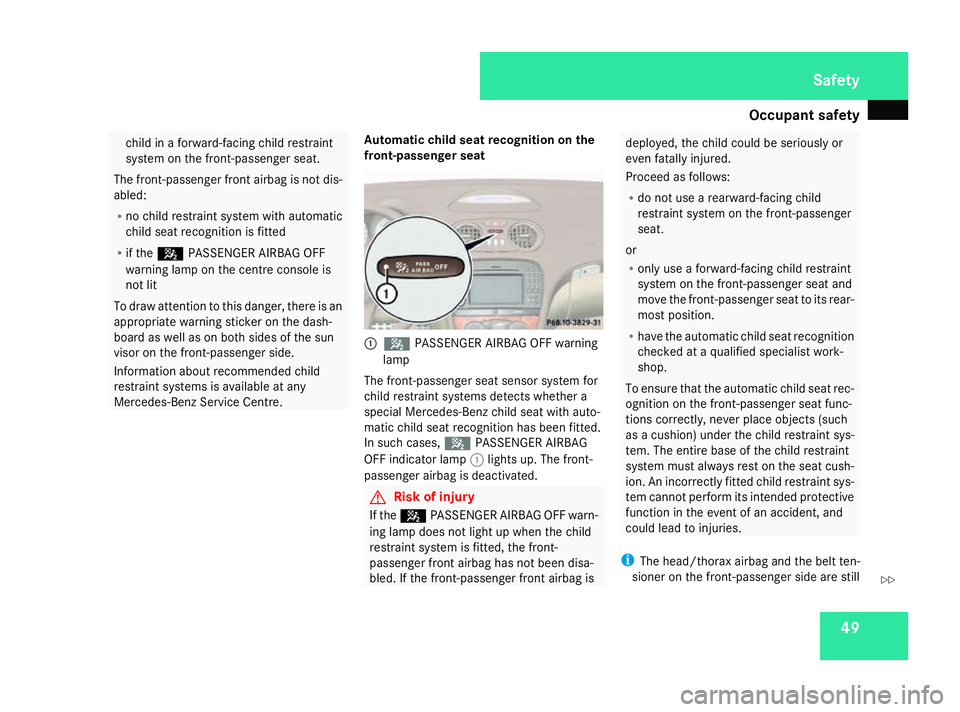
Occupant safety
49child in
aforward-facin gchild restraint
system on the front-passenger seat.
The front-passenger fron tairbag is not dis-
abled:
R no child restraint system with automatic
child seat recognition is fitted
R if the 5 PASSENGER AIRBA GOFF
warning lamp on the centre console is
not lit
To draw attention to this danger, ther eisan
appropriate warning sticker on the dash-
board as well as on both sides of the sun
visor on the front-passenger side.
Information about recommended child
restraint systems is available at any
Mercedes-Benz Service Centre. Automatic child seat recognition on the
front-passenger seat 1
5 PASSENGER AIRBAG OFF warning
lamp
The front-passenger seat sensor system for
child restraint systems detectsw hether a
special Mercedes-Benzc hild seat with auto-
matic child seat recognition has been fitted.
In such cases, 5PASSENGER AIRBAG
OFF indicator lamp 1lights up. The front-
passenger airbag is deactivated. G
Risk of injury
If the 5 PASSENGER AIRBAG OFF warn-
ing lamp does not light up when the child
restraint system is fitted, the front-
passenger front airbag has not been disa-
bled. If the front-passenger front airbag is deployed, the child could be seriously or
even fatally injured.
Proceed as follows:
R
do not use arearward-facing child
restraint system on the front-passenger
seat.
or
R only use aforward-facing child restraint
system on the front-passenger seat and
move the front-passenger seat to its rear-
most position.
R have the automatic child seat recognition
checked at aqualified specialist work-
shop.
To ensure that the automatic child seat rec-
ognition on the front-passenger seat func-
tions correctly, never place objects( such
as ac ushion) under the child restraint sys-
tem. The entire base of the child restraint
system must always rest on the seat cush-
ion. An incorrectly fitted child restraint sys-
tem cannot perform its intended protective
function in the event of an accident, and
could lead to injuries.
i The head/thorax airbag and the belt ten-
sioner on the front-passenger side are still Safety
230_AKB; 5; 4, en-GB
bjanott ,V ersion: 2.9.6
2008-04-08T15:09:54+02:00
-Seite 49 ZDateiname: 6515_3089_02_buchblock.pdf; preflight
Page 53 of 317
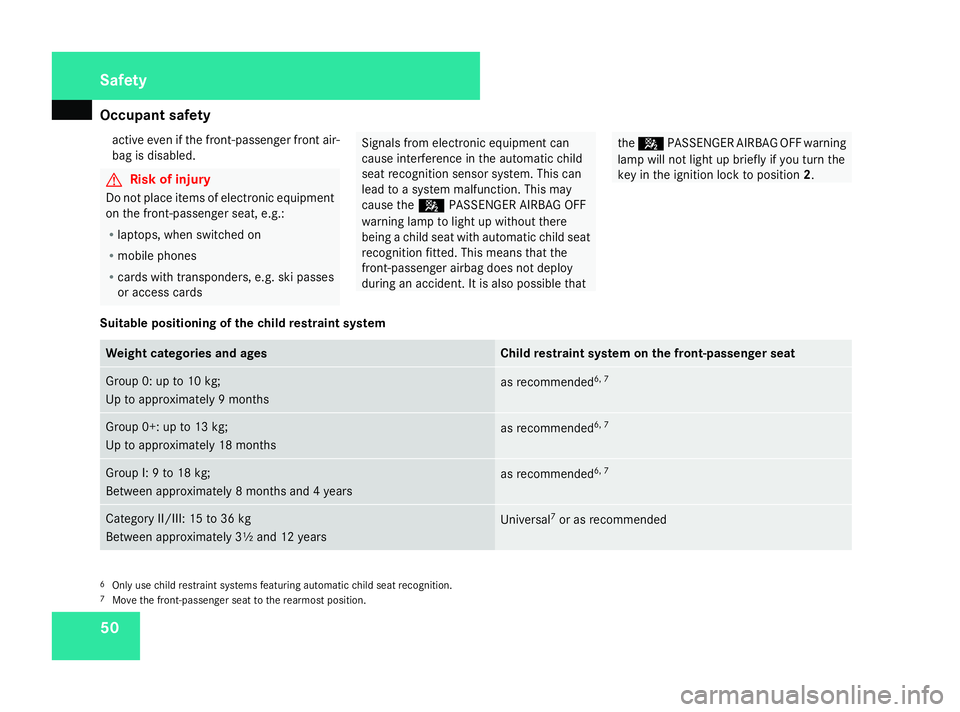
Occupant safety
50activ
eeven if the front-passenger fron tair-
bag is disabled. G
Risk of injury
Do not place items of electronic equipment
on the front-passenger seat, e.g.:
R laptops, when switched on
R mobile phones
R cards with transponders, e.g. ski passes
or access cards Signals from electronic equipment can
cause interference in the automatic child
seat recognition sensor system. This can
lead to
asystem malfunction .This may
cause the 5PASSENGER AIRBAG OFF
warning lamp to light up without there
being achild seat with automatic child seat
recognition fitted. This means that the
front-passenger airbag does not deploy
during an accident. It is also possible that the
5 PASSENGER AIRBAG OFF warning
lamp will not light up briefly if you turn the
key in the ignition lock to position 2.
Suitable positioning of the child restraint system Weight categories and ages Child restraint system on the front-passenger seat
Group 0: up to 10 kg;
Up to approximately
9months as recommended
6, 7 Group 0+: up to 13 kg;
Up to approximately 18 months
as recommended
6, 7 Group I:
9to18k g;
Between approximately 8months and 4years as recommended
6, 7 Category II/III: 15 to 36 kg
Between approximately 3½ and 12 years
Universal
7
or as recommended 6
Only use child restraint systems featurin gautomatic child seat recognition.
7 Move the front-passenger seat to the rearmost position. Safety
230_AKB
;5;4,en-GB
bjanott, Version:2.9.6
2008-04-08T15:09:54+02:0
0-Seite 50 Dateiname: 6515_3089_02_buchblock.pdf; preflight